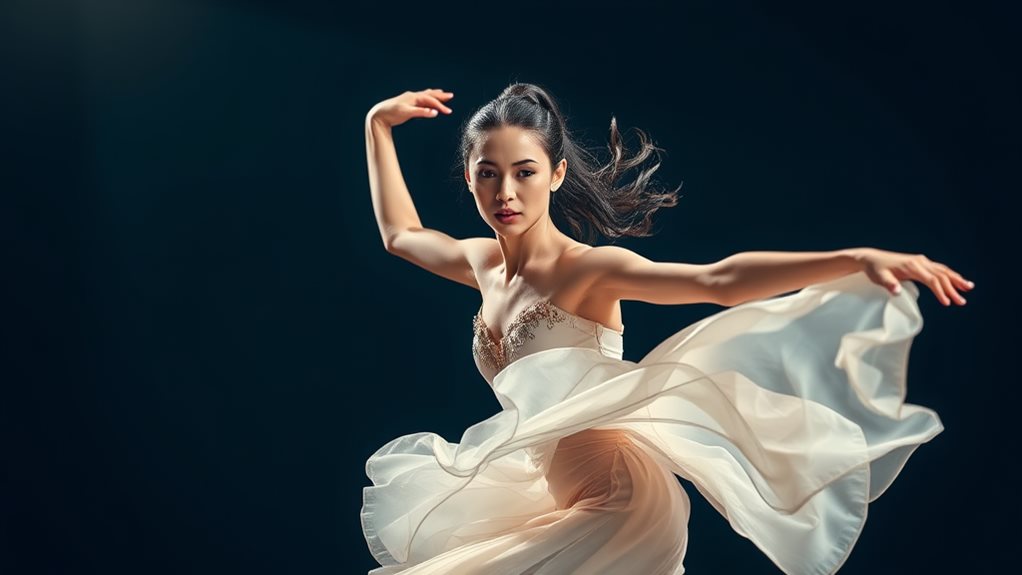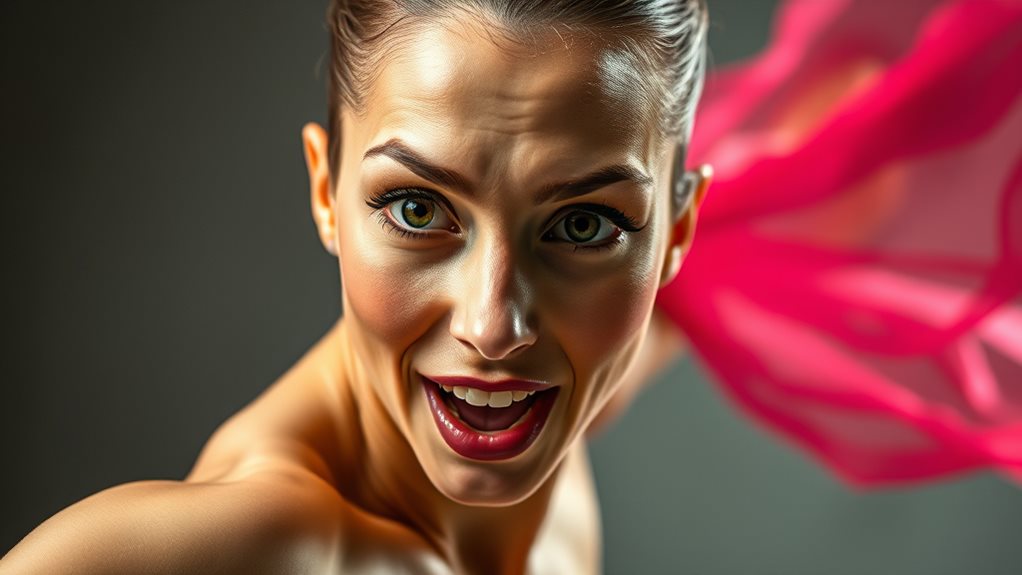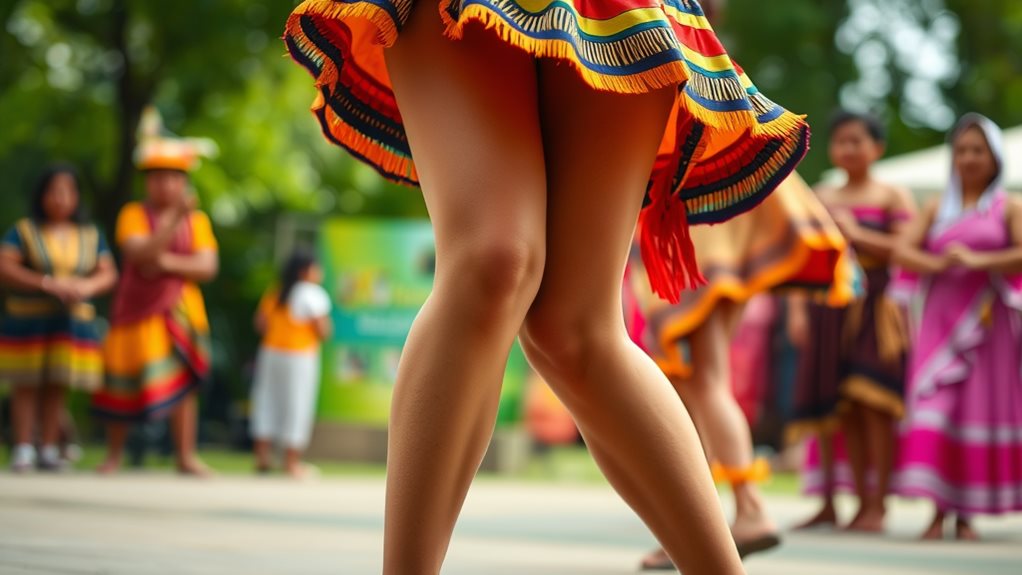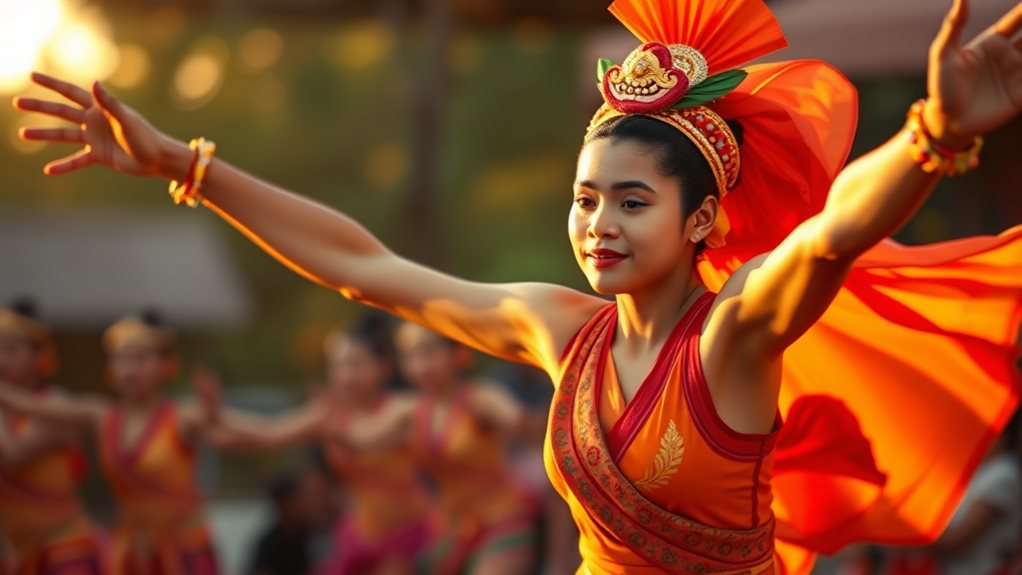Capturing Movement in Filipino Dance Photography
Mastering Technical Skills
To freeze the fast-paced movements in dances like Tinikling, use fast shutter speeds**. On the other hand, slower shutter speeds can emphasize the elegance of dances like Rigodon. Control your aperture** to decide whether to focus on a single dancer or the entire group.
Composition and Cultural Sensitivity****
Mastering composition involves using dynamic angles and incorporating leading lines to add depth to your images. To respectfully represent Filipino dance, research the cultural significance**** of costumes, expressions, and traditions. This understanding will help you capture the essence of the dance.
Post-processing and Emotional Depth****
Refine your images through post-processing to convey the emotional depth of the dance. This step helps to enhance the mood and atmosphere of your photographs.
The Key to Capturing Filipino Dance
The interplay of technical skill and cultural sensitivity is crucial to capturing the vitality of Filipino dance. By mastering these elements, you can produce vibrant and meaningful images that showcase the beauty of Filipino dance.
Essential Camera Skills

Mastering Shutter Speed
To capture Filipino dance photography, understanding shutter speed is crucial. A fast shutter speed of at least 1/500th of a second freezes movement, ideal for sharp images of fast-paced steps. For example, if you're capturing a Tinikling dance, a fast shutter speed will help you freeze the rapid footwork.
For incredibly quick actions, increase the shutter speed to 1/1000th or 1/2000th to ensure a sharp image.
On the other hand, slower shutter speeds (1/100s or slower) create motion blur, conveying a sense of fluidity****. This can be useful when capturing a graceful dance like the Rigodon.
Experimenting with different shutter speeds will help you achieve the desired effect.
Controlling Aperture
Aperture settings are equally important for controlling depth of field. A wide aperture (f/4 or wider) isolates dancers against a blurred background, drawing focus to the subject. For instance, if you're capturing a solo dancer, a wide aperture will help separate them from the background.
Narrower apertures, however, keep multiple dancers in focus, useful in group shots****. This is ideal for capturing the interaction between dancers in a group performance.
Understanding Focus
Understanding focus is vital in capturing Filipino dance photography. Employ back-button focusing for better control, separating focusing and shutter release functions. This technique helps you focus on the subject and then take the shot, ensuring a sharp image.
Utilize continuous autofocus (AI Servo/AF-C) to smoothly track moving dancers in burst mode, capturing crucial moments. This feature is particularly useful when capturing fast-paced dances like the Maglalatik.
Mastering Dance Lighting
Mastering Dance Lighting
Understanding Light and Its Impact
Mastering shutter speed and aperture is crucial, but lighting plays a significant role in capturing the mood and impact of Filipino dance photographs.
Light Placement and Angles
Light placement and dynamic angles interact to create compelling images. Experiment with fast shutter speeds (1/1000 second or faster) and flash for sharp motion freezing, adjusting ISO and aperture to balance exposure. Consider integrating ambient light using slower speeds, higher ISO, and wider apertures for a richer atmosphere.
Utilizing Strobes Strategically
High-speed sync allows for faster shutter speeds with strobes, enabling you to freeze motion effectively. Experiment with various flash durations and power settings to avoid overheating. Position strobes creatively – to the sides or above – to generate dynamic lighting. Explore the "blurry but sharp" effect by combining flash with slow shutter speeds.
Light Sources and Techniques
| Light Source | Technique | Effect | Considerations |
|---|---|---|---|
| Studio Strobes | Precise placement, gridded softboxes | Controlled, dramatic lighting | Power settings, heat management |
| Natural Light | Window light, open space | Soft, diffused illumination | Time of day, weather conditions |
| Mixed Lighting | Combine flash and ambient light | Depth and atmosphere | Balance exposure, creative blending |
| Flash with Slow Shutter | Motion blur with sharp subject | Dynamic energy and movement | Requires practice |
Studio Settings and Safety
In studio settings, gridded strip light softboxes offer precise control. Protect your equipment from dust. Always prioritize safety, taking breaks and ensuring adequate ventilation. Pre-plan your lighting setups and test them beforehand, receiving feedback from dancers to refine your approach, ensuring your images capture the energy and emotion of the dance.
Showcasing Facial Expressions

Capturing Emotional Depth in Filipino Dance Photography
To effectively capture the essence of Filipino dance, it's crucial to showcase the dancers' facial expressions****, which reflect the story, emotion, and cultural significance of the performance. Mastering this aspect elevates your photography, transforming simple movement into compelling emotion storytelling.
Authenticity is Key
Capture genuine emotion to convey the true essence of the dance. For instance, a candid smile during a celebratory dance like the Tinikling contrasts sharply with the focused intensity of a ritualistic dance such as the Sagayan. These differences are vital to understanding the diversity of Filipino dance.
Focus on Expressive Gestures****
Pay close attention to the eyes and eyebrows, which are powerful tools in conveying the subtle nuances of emotion and intention. In dances like the Pangalay, subtle facial movements are integral to the narrative.
Contextualize the Performance
Remember that the setting and background influence how these expressions are interpreted. A group shot reveals the collective energy and interaction among dancers, adding another layer of understanding.
Aim to capture the full spectrum: joy, concentration, reverence, and storytelling within the same performance. High shutter speeds and sharp focus are essential to freeze those dynamic, expressive gestures.
Cultural Sensitivity in Shots
Accurate Representation of Filipino Dances Requires Cultural Immersion****
To respectfully portray Filipino dances, you need to be sensitive to the rich cultural context that informs each performance. Research is key: Before filming, study the specific ethnolinguistic group, such as Ata Manobo, Yakan, or Maguindanao, whose dance you're documenting. Understand their historical context, ancestral lands, and the significance of the movements. Collaborating with groups like Parangal Dance Company provides invaluable insights.
Recognize Nuances in Dance
Respectful portrayal involves recognizing nuances: Some dances, particularly those of Muslim communities in Mindanao, emphasize stoicism; capturing this requires sensitivity and awareness.
Accurately depict traditional attire and accessories: Understand their significance. For example, metal fingernails in Pangalay aren't mere decorations, but integral to the dance's aesthetic and meaning. Pay close attention to posture and movements unique to each dance form, avoiding generic or stereotypical representations.
Be mindful of cultural taboos****.
Active Engagement in Cultural Immersion
Cultural immersion isn't passive observation; it's active engagement****: Seek feedback from community members and practitioners to ensure your work authentically reflects their traditions.
Avoid appropriation by giving proper credit and acknowledging the dancers and their communities. Your photography should contribute to cultural preservation, not exploit it.
A collaborative approach guarantees a respectful portrayal****, celebrating the dance's artistry and cultural depth while supporting Indigenous communities and their rich heritage.
Composition and Framing Tips

Mastering Composition Techniques
To take your Filipino dance photographs to the next level, master key compositional techniques. The rule of thirds is essential, using your camera's grid to offset subjects for better balance and visual storytelling.
Leading lines, whether straight or curved, guide the viewer's eye, adding depth and interest to your images. Foreground interest creates a sense of depth, but ensure it doesn't overshadow your dancers.
Capturing Dynamic Angles****
To convey the energy of the performance, experiment with dynamic angles. Shoot from low angles to emphasize the dancers' height and power.
Utilize high angles for a different perspective, showing the overall choreography. Try unusual angles to create unique and compelling compositions.
Framing for Impact
Fill the frame effectively to focus attention on key moments and facial expressions, crucial for visual storytelling.
Strategically position dancers within the frame to create more impactful images that showcase the beauty and dynamism of Filipino dance.
Use framing to highlight the intricate details of the costumes or the emotions displayed by the dancers. The composition of your shots is key to the success of your visual storytelling, showing viewers not only what's happening in the performance, but how captivating it is.
Coordination and Timing
Precise Coordination and Timing are Crucial
Mastering composition is only half the battle; precise coordination and timing are equally vital for capturing the dynamism of Filipino dance. To achieve this, meticulous pre-planning is necessary, involving the creation of a shot list highlighting key dance moves and beats.
Collaboration with the dancer is also essential, as their feedback is invaluable for ensuring accurate capture of the intended movements.
Understanding Rhythm and Beats
Understanding the rhythm and beats is crucial for dance synchronization. Test runs and rehearsals help identify optimal shooting positions and refine timing techniques.
Continuous autofocus is also essential for tracking swift movements, leveraging the camera's fast autofocus system and face/eye-tracking capabilities.
Visual Storytelling
Low-angle shots add visual impact to the dancer's presence.
Coordinating with assistants for dynamic flour-throwing or prop-related shots enhances visual storytelling effectively.
Lighting choices directly impact the ability to capture the dance's energy. Utilizing strobes with short flash durations and high-speed sync results in sharp, motion-freezing images, while adjusting power settings avoids overexposure.
Capturing the Spirit
Experimenting with slow shutter speed combined with flash creates a "blurry but sharp" effect.
Protecting equipment from potential dust or debris is also necessary.
Careful backdrop selection, equipment stabilization (monopod or tripod), and the strategic inclusion of visual elements like fabrics and props all contribute to the overall impact of the images.
Adjusting camera settings (ISO, aperture, shutter speed) to suit the lighting is also crucial.
Tethered shooting allows for real-time monitoring and adjustments.
Through precise coordination and timing, you can transcend merely documenting movement and truly capture the spirit of Filipino dance.
Post-Processing and Editing

Post-processing refines your images into compelling visual narratives. It involves essential adjustments to transform your shots into powerful visual statements.
Begin by correcting the color to match the lighting, tweaking the exposure for balanced brightness, and reducing noise for clarity.
Motion is a crucial aspect of Filipino dance photography. To emphasize the dancer's movement, strategically use motion blur, selectively sharpen key elements, and blur the background.
This background enhancement isolates the dancer and enhances their performance.
Creative adjustments can evoke specific moods and strengthen the atmosphere. Experiment with:
Color grading to complement the costumes and evoke a specific mood. For example, a warm tone can convey energy and passion, while a cool tone can convey serenity and elegance.
Vibrance and saturation adjustments to intensify the colors. Subtly increase or decrease these settings to draw attention to specific elements in the image.
Delicate use of effects and filters to strengthen the overall atmosphere. Apply a subtle glow effect to highlight the dancer's movements or use a filter to add texture and depth to the image.
Questions and Answers
What Lenses Are Best for Dance Photography?
Prime lenses are ideal for dance photography due to their exceptional sharpness and low-light performance. They allow you to capture crisp images even in dimly lit studios or theaters. However, zoom lenses offer versatility and flexibility, which can be useful when you need to quickly switch between different shot types or compositions. Consider your specific needs: if you want to capture the grandeur of the dance stage, a wide-angle lens (between 10-24mm) is a good choice. On the other hand, if you want to focus on a specific dancer or highlight a particular movement, a telephoto lens (70-200mm or more) can help you isolate the subject.
How Do I Edit Dance Photos for a Consistent Look?
Achieve a consistent look in dance photos by mastering two essential techniques: color grading and strategic motion blur.
Color grading involves adjusting the color palette to create a uniform tone across all images. To do this, select a dominant color and apply it consistently throughout the series. For example, if the dance costumes are blue, emphasize blue hues in the editing process to create a cohesive look.
Motion blur adds a sense of dynamism to dance photos. Use motion blur strategically to convey movement and energy. For instance, blur the dancer's arms or legs to suggest motion, but avoid overusing this effect to prevent a blurry mess. By balancing color grading and motion blur, you'll create a visually striking and consistent series of dance photos.
What Backup Equipment Should I Bring?
Backup Equipment Essentials
To ensure uninterrupted photography sessions, it is crucial to bring backup equipment. A backup camera body is a must-have in case your primary camera fails or is damaged. Additionally, extra lenses can serve as replacements in case your primary lens is compromised.
Stability and Power
A sturdy tripod is essential for maintaining stability and preventing camera shake. Battery backups are necessary to prevent workflow interruptions caused by power depletion. Sufficient memory cards guarantee continuous shooting without interruptions due to storage limitations.
How Do I Handle Unexpected Lighting Changes?
Adapting to Unexpected Lighting Changes
When dealing with unexpected lighting changes, mastering manual mode is crucial for precise control. This allows you to adjust exposure settings instantly, which is essential when lighting conditions shift suddenly.
Bracketing shots is another valuable technique to handle unexpected lighting changes. By taking multiple shots of the same scene at different exposure levels, you can later combine them to create a single image with the optimal lighting.
Where Can I Find Affordable Dance Photography Gear?
Online marketplaces offer affordable dance photography gear options. Websites like eBay and Amazon provide a range of budget-friendly choices. Consider exploring used gear, which can significantly reduce upfront costs. Alternatively, renting equipment can be a cost-effective solution.
Budget-friendly DSLRs and camcorders are readily available. For instance, Canon EOS Rebel series and Nikon D3500 are affordable DSLR options. Similarly, camcorders like Sony HDRCX405 and Canon VIXIA HF R800 are budget-friendly choices.